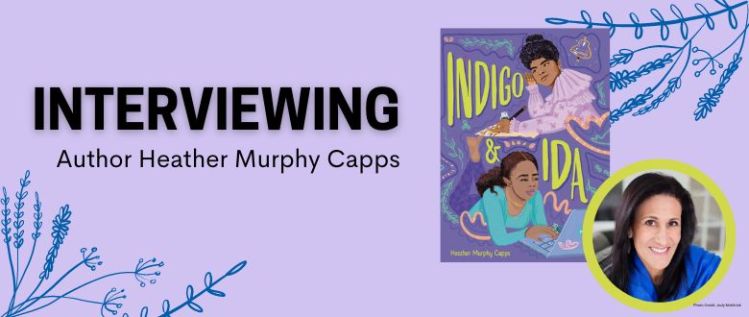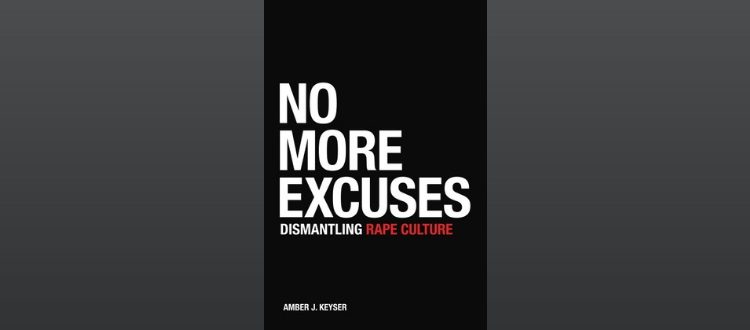Indigo and Ida: An Interview with Author Heather Murphy Capps

In the brand new middle grade Indigo and Ida, Indigo is an eighth-grade investigative reporter, and she’s taking the world by storm. She breaks an important story, exposing an unfair school policy, she’s suddenly popular for the first time. But when she notices that the school’s disciplinary policies seem to be enforced especially harshly with students of color, her friends insist she’s imagining things. Indigo draws strength from the story of the trailblazing Ida B. Wells who fought for racial justice.
Today author Heather Murphy Capps joins us to discuss why she wrote this story, the origins of Indigo’s name, and the her hopes for young readers. Keep reading to download the free discussion guide and enter a Goodreads giveaway!

What is the origin story for your book?
I wanted to write a story about friendship, specifically to investigate why some friendships last while others fall apart. For several years, while I drafted other books, I noodled about this one, and then one day at a museum exhibit, all the pieces fell into place. The exhibit narrated the story of how Ida B. Wells helped Alice Paul and her team organize and prepare for the Woman Suffrage Parade in 1913. But when the big day arrived, Paul told Wells that she would have to march in the back of the parade with the other Black women because to march up front alongside the white women would anger Southerners. Paul didn’t want to risk losing the strong political power of the Southern women, so she threw Ida under the bus.
When I learned this story, I was overwhelmed. I felt so deeply, so viscerally, a sorrowful connection to Ida in that moment when she realized her friend wasn’t the person Ida thought she was. We’ve all been there, and even when the stakes aren’t as high as these, it still hurts, and the betrayal is still very real. I couldn’t stop thinking about Ida.
That was when Indigo—a journalist like Ida—was born, along with the idea that I wanted to write a story that would connect the two across the centuries.
Where does Indigo get her name?
I named Indigo after the singing duo Indigo Girls because their song “Galileo” was part of my internal soundtrack as I wrote this book. In fact, the lyrics from the song were actually part of the opening scene in the early drafts. But I didn’t have the rights to reprint those lyrics, so instead I chose an equally awesome quote from Winnie the Pooh, which is in the public domain.
How did you connect the two characters across the centuries?
No spoilers here, but Indigo finds a treasure trove of historic letters written by Ida. The letters narrate pivotal points in Ida’s life, and Indigo reads them as she is navigating pivotal points in her own life. Sadly, the issues Indigo faces have many similarities to the issues Ida wrote about 150 years ago.
What was one of the biggest surprises you had?
When I read Ida B. Wells’s pamphlets Southern Horrors and the Red Report, which were both deeply investigated reports on the crisis of lynching in America, I was shaken to see that some of the justifications for disproportionate incarceration and violence toward Black men were the same back then as we hear and see today. For example, Black men were often accused of crimes they didn’t commit—and those accusations were then used to unjustly beat, convict, or even lynch them.
What was the hardest part of this book to write?
There is a section in my book where Ida talks about a violent incident that happened to a friend of hers in a neighborhood called the Curve. This incident affected her life and her work profoundly. Just as I was researching that, George Floyd was murdered in my home state of Minnesota. I actually had to stop writing for a while because I, like the rest of the world, was devastated. And just like Indigo, I found courage to go back to writing because that’s what Ida did too.
How did you find each character’s voice?
I found Ida’s voice in her own writing. I read her autobiography, her pamphlets, some of her newspaper columns, some of her letters—as much as I could get my hands on. I wasn’t able to see all her archived work, but I did the best I could to read whatever I could access remotely during Covid. I discovered that she was quite direct and concise, which I loved. But she also deeply felt the pain of the injustice she reported so thoroughly and worked so hard to correct. I am grateful that so much of her work still exists so that we can see for ourselves what an extraordinary person she was. A literary tradition in Black American fiction illustrates the concept of the two voices—public and private (W. E. B . DuBois’s “double consciousness”). I find that for me this idea is similar to “code switching.” There’s the outward voice, the public-facing personality that covers up the parts of us that don’t fit in a default white society, and then there’s the private personality and voice, for when we feel safe being ourselves within our own community. So Indigo has two voices—the one she uses at school, where she’s trying to fit in and where she’s shushed when she tries to speak out about the injustice she finds; and her private voice, which is empowered by Ida’s voice urging her to speak her truth.
Who did you write this book for?
I wrote this book for anyone who’s ever been afraid to speak up, for those who’ve been told they’re “crazy” or overreacting when they dare to call out the wrongs they see. I wrote this for girls who have been told they’re too loud, too ambitious, too strident. This is also for anyone who’s ever lost a friend and didn’t see it coming. I know—I really know—how badly it hurts. Truth be told, it probably always will hurt a little bit, but you will survive. And even though it’s clichéd, the truth is that the friends who stick around—the ones you can disagree with, go through awkward times with, even struggle a little with, and still stay close to—those are the ones you were meant to stick with.
Goodreads Giveaway
Enter the Lerner Goodreads Giveaway for an advanced review copy of Indigo and Ida! April 30th is the last day to enter and after that we’ll mail copies out to five lucky winners.

Free Educator Resources
There’s a lot of story to cover in Indigo and Ida. Download this free discussion guide to start open conversation with your students during and after reading.
Connect with Heather

Heather Murphy Capps writes about history, social justice, science, and magic. She is a mother of two, an Army wife, and an education equity activist. As a biracial author, she’s passionate about creating more diversity in publishing. Indigo and Ida is her debut novel.
Photo Credit: Jody McKitrick
Praise for Indigo and Ida
★ “Indigo is a relatable and sympathetic character, and the social justice issues she champions at her school are timely and ring true. Readers will be inspired by Indigo’s passion and compelled to read more about Wells, too.” — starred, Booklist
★ “[A] powerful and climactic contemporary novel.” — starred, Shelf Awareness
“This lively middle-grade novel successfully captures the turmoil of finding one’s place while navigating the various demands of growing up. . . . A satisfying story that demonstrates how the past can shed light on the present.” — Kirkus Reviews
“In Capps’s endearing debut, biracial (white and Black) eighth grader Indigo Fitzgerald faces scrutiny and microaggressions from her peers during her campaign for class president. . . . Forthright conversations surrounding privilege between Indigo and her white mother further elevate this complex depiction of race and discrimination.” — Publishers Weekly
Visit our author and illustrator spotlight page to find more insights from Lerner creators!


Comments